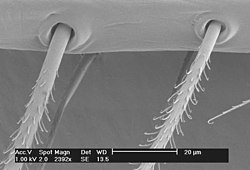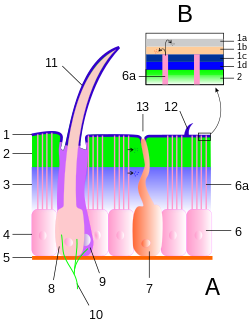Trichobothrium

Trichobothria (singular Trichobothrium ; ancient Greek θρίξ thrix , Gen. τριχός trichós , German 'hair' and ancient Greek βοθρίον bothríon 'dimple') are very long whiskers (setae) in some arthropods . They are movably guided into recesses in the cuticle and serve as mechanosensitive sensory organs , which respond particularly to air vibrations and enable hearing. Most of all, they appear on the legs and pedipalps of arachnids . But some insects (like beetles and Schnabelkerfe ) also carry Trichobothria. In the course of evolution , Trichobothria probably originated three times in parallel . The development of Trichobothria in scorpions can be traced back to the Cretaceous Period .
Orientation through Trichobothria is called Orthobothriotaxis . Another, much smaller form of surface sensors of the cuticle is the Sensilla .

1 epicuticle, B details the epicuticle:
1a cementum, 1b wax layer 1c epicuticle externa, 1d epicuticle interna
2 exocuticle, 3 endocuticle
2 + 3 Procuticula
4 epithelial 5 basement membrane
6 epithelial cell, 6a pore channels
7 gland cell
8 Cuticulagrube (Bothrion )
9 heat receptive cells
10 nerve endings
11 trichobothrium
12 sensillum
13 glandular openings
Structure and function
Since arthropods have a hard and rigid shell made of sclerotin and chitin , mechanosensitive ion channels in nerve membranes must be supplied with external mechanical stimuli through the exoskeleton .
Trichobothria react very sensitively to the currents of the medium (mostly air movements), because the hair structures of chitin threads arise from a cuticle pit. The largest number of Trichobothria found so far in a spider is around 100 Trichobothria per leg in the Central American nocturnal hunting spider, Cupiennius salei , which sits in wait for insects . The fine threads with a diameter of 5 to 15 µm only protrude from the cuticle surface by 100 to 1500 µm. So that they can even be deflected by the slightest air movement, they are inserted into the cuticle through a thin, stretched membrane. The excitation threshold decreases with increasing thread length ; it is at air speeds of less than 1 mm / s. The angle of deflection is limited to a maximum of 25 to 35 ° by the edge of the cuticle pit.
Beetles can carry Trichobothria of different types on their abdomen of different lengths and thus hear, this can serve to communicate with one another. Schnabelkerfe like bedbugs carry Trichobothria on their antennae .
perception
Flying insects generate air vibrations of frequencies up to about 600 Hz, and since Trichobothria behave like low pass filters , they respond to such low frequencies. The longer the thread hairs are, the better the lower frequencies are transmitted. In this way, the vibration sensitivity can be adapted to the frequency range that is important for your lifestyle. A film of still air forms on every surface that is flowed over. The hair must protrude from this so-called boundary layer so that the Trichobothria can react properly. As the flow frequency decreases, the thickness of this boundary layer increases. The hair length is optimally adjusted when it is inversely proportional to the root of the stimulus frequency . Just as long Trichobothria can be deflected almost equally well in all directions, there is instead selectivity for the short ones, which is not caused by the asymmetrical edges of the cuticle pits, but by the properties of the joint membrane. The Trichobothria are innervated at the insertion of three or four mechanosensitive dendrites , each dendrite responding to a certain deflection sector. So directional sensitivity only arises during the transduction process due to the position of the dendrites in the joint. It has not yet been precisely researched whether the pressure on the dendritic membrane is the appropriate stimulus .
The power transmission from the air particles to the hair is viscous , the thread is carried along by the friction of the air particles on the hair shaft. Fine featherings on the hair promote this power transmission through friction. In most Trichobothria, the amplitude ratio between hair deflection and air particle movement is 1: 2 to 1: 1. There are also individual Trichobothria in which the hair deflection is greater than the air particle movement. The hair deflection correlates with the air particle acceleration and the speed, the latter is also called the speed of sound . The speed of sound is only noticeable in the near field, as it decreases very quickly with distance, values of up to 30 cm are realistic. This space recorded by sensors is sufficient in relation to the body size of a spider.
The hunting spider Cupiennius salei can locate its prey with these vibration sensors , which receive a sufficiently wide range of air vibration strengths and frequencies due to different hair lengths. It can even catch flying insects from the air. For example, it can detect a buzzing fly from a distance of 30 cm and a fly flapping its wings from a distance of 70 cm. The main food of the spiders are insects running on the leaves, these generate air currents of 20 mm in their radius, to which the Trichobothria react, whereby the spider orientates itself in the direction of the prey.
literature
- Rainer F. Foelix: Biology of Spiders. Harvard University Press, Cambridge MA et al. 1982, ISBN 0-674-07431-9 .
- Pierre-P. Grassé: Traité de Zoologie. Anatomy, systématique, biology. Tome 6: Onychophores - Tardigrades - Arthropodes - Trilobitomorphes - Chélicérates. Masson et Cie, Paris 1968.
- Jeffrey W. Shultz: Evolutionary Morphology And Phylogeny of Arachnida. In: Cladistics. Vol. 6, No. 1, 1990, ISSN 0748-3007 , pp. 1-38.
Web links
- The breath of air that announces the fly , report by Veronika Schmidt, Die Presse , May 26, 2012
Individual evidence
- ↑ a b c Peter Görner: A proposed transducing mechanism for a multiply-innervated mechanoreceptor (trichobothrium) in spiders. In: Cold Spring Harbor Symposia on Quantitative Biology. Volume 30. Cold Spring Harbor Laboratory Press, 1965, doi: 10.1101 / SQB.1965.030.01.010 .
- ↑ a b Kazimir V. Drašlar: Functional properties of trichobothria in the bug Pyrrhocoris apterus (L.). In: Journal of Comparative Physiology 84, No. 2, 1973, pp. 175-184.
- ↑ Aleš Škorjanc, Samo Batagelj, Kazimir Drašlar: Thermal acclimatization does not affect the resting activity of type T 1 trichobothrium in the firebug (Pyrrhocoris apterus; Heteroptera). In: Acta Biol Slov 50, No. 2, 2007, pp. 85-92.
- ↑ a b c J. Zrzavý: Antennal trichobothria in Heteroptera: a phylogenetic approach. In: Acta Entomologica Bohemoslovaca 87, No. 5, 1990, pp. 321-325.
- ^ A b Michael E. Soleglad, Victor Fet: Evolution of scorpion orthobothriotaxy: a cladistic approach. In: Euscorpius 2001, No. 1, 2013, pp. 1–38.